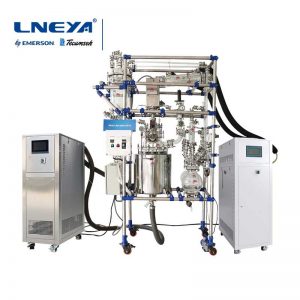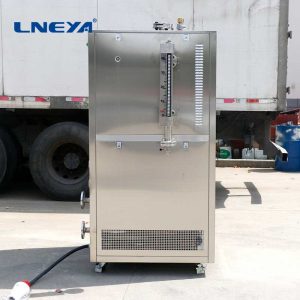Recirculating Chiller For Rotary Evaporator
Choosing the right cooling method for a laboratory rotary evaporator can have an unimaginable impact on the performance, economy and efficiency of the overall system. As a necessary stage of the distillation process, the commonly used condensation methods currently include: using dry ice condensers, equipped with or building a cooling cycle system by yourself, and using tap water for steam cooling. But in most cases, you need to buy recirculating chiller as supporting equipment.
Lorsque le circulateur réfrigéré fonctionne, il refroidit le liquide de refroidissement rempli dans le réservoir d'eau grâce à son système de réfrigération, et la pompe intégrée pompe le liquide de refroidissement dans le tuyau du condenseur pour absorber la chaleur de la vapeur dans le condenseur afin d'obtenir l'effet de condensation. Le liquide de refroidissement à température élevée retourne dans le réservoir d'eau pour se refroidir à nouveau. De cette manière, le refroidissement circule et est échangé pour fournir une température de condensation stable au système d'évaporation rotatif, tout en évitant efficacement les fluctuations de température saisonnières qui peuvent se produire lorsque de l'eau du robinet est utilisée. En outre, le choix d'un refroidisseur efficace et respectueux de l'environnement pour remplacer l'eau du robinet pour le refroidissement aidera également le laboratoire à économiser de l'eau.
Important factors to consider when choosing the right recirculating chiller include:
Température minimale de condensation et capacité de refroidissement correspondante
02. Cycle pressure
03. Circulation flow
04. Suitable accessories
05. Chiller selection guide
Température minimale de condensation et capacité de refroidissement correspondante
The minimum temperature of the coolant needs to be below the temperature at which the rotovap condenser will condense the solvent vapor at an optimal rate. This temperature is determined by the boiling point of the solvent. When selecting and setting the temperature of the recirculating chiller, it is generally recommended to follow the “rule of 20”, that is, set a temperature difference of 20°C between the heating pot temperature and the steam temperature, and between the steam temperature and the condenser temperature. For example, set the heating pot temperature to 60°C, adjust the vacuum settings of the system to generate solvent vapor at 40°C, and operate condensation at 20°C. Therefore, the solvent vapor temperature is 20°C lower than the heating pot temperature, and the condenser temperature is 20°C lower than the steam temperature.
The lower the temperature that the recirculating chiller can provide, the better the condensation effect. The recirculating chiller usually has the maximum cooling capacity at 20°C or normal temperature, that is, the maximum cooling power parameter under ideal conditions, which is often the nominal cooling power marked by the manufacturer. For example, our company’s LX recirculating chiller has a cooling capacity of 1000W when the water temperature is 20°C, and the cooling capacity is halved when the water temperature is 5°C, that is, the cooling capacity is about 500W.
As the temperature gets lower, the cooling capacity that the recirculating chiller can achieve decreases. If the recirculating chiller is at the set temperature, the cooling capacity is not enough to take away the heat of the cooling liquid in the distillation, which means that the cooling liquid will not be able to reach the set temperature in the actual distillation, and the ideal condensation efficiency will not be achieved. Therefore, the cooling effect of the recirculating chiller needs to comprehensively consider the two parameters of temperature and cooling capacity.
If the rotary evaporator needs to distill multiple solvents, then the cooling capacity of the recirculating chiller should be selected according to the required minimum condensation temperature. By checking the product specifications, you will find that the recirculating chiller has different cooling capacities corresponding to different temperatures. If the condenser is required to work at a relatively low temperature, it is necessary to have a deep understanding of the cooling capacity of the recirculating chiller at a relatively low temperature, that is, the cooling capacity.
If the recirculating chiller has insufficient power at its set temperature, it means that the cooling liquid will not be able to reach the set temperature during the actual distillation, so that it will not be able to provide enough heat transfer effect to effectively condense the steam. Vapor that cannot be cooled in time will be sucked into the vacuum pump, increasing wear and shortening the service life of pump components, and may even cause irreparable damage. In addition, if your recirculating chiller has an over-temperature alarm function, setting the temperature too low may cause the equipment to alarm and shut down, and the distillation experiment will be interrupted.
02. Cycle pressure
Another important factor to consider is the pressure range of the recirculating chiller’s recirculating pump. The pump pressure for a recirculating chiller is usually in the range of 10-15 psi (0.67-1.03 bar). If the pump pressure is too low, once there is a certain height difference between the rotary evaporator and the refrigerated circulator (for example, the equipment is placed under the test bench), the coolant will not be able to circulate effectively in the condenser. If the pump pressure is too high, the risk of rupture inside the glass condenser due to excessive coolant pressure increases dramatically. The maximum internal pressure of a common glass condenser is 1.5bar, so it is necessary to pay attention to the applicable range of the pressure.
When purchasing a recirculating chiller, it is necessary to confirm the pressure range of the equipment and the working pressure range of the rotary evaporator condenser. In general, most equipment compatible with rotary evaporators has a maximum pump pressure of 11.5 psi (≈0.8 bar), making them suitable for use with glass condensers. If a positive displacement pump and a turbo pump are configured, they often have a higher output pressure, so more attention should be paid to their pump pressure range, so as to avoid the risk of glass condenser rupture due to the use of the corresponding recirculating chiller, or the cooling liquid caused by insufficient pump pressure. Cannot loop effectively.
03. Circulation flow
The pump flow rate of the recirculating chiller affects the residence time of the coolant in the condenser. The lower the flow rate, the longer the coolant stays in the condenser. As the temperature increases, the efficiency of heat transfer between the steam and the coolant decreases. In this case, there is an increased risk of insufficient condensation of solvent vapors.
Although the current flow of most recirculating chillers is sufficient relative to their cooling power, it is still necessary to pay attention to this point.
04. Suitable accessories
Coolant and enhanced cooling water pipeline, according to the temperature range, select the appropriate coolant.
If lower temperatures are required, ethanol or glycol mixtures are recommended. The common coolant is a mixture of ethylene glycol and water containing inhibitors. The working temperature ranges from -30 to +90°C and the ignition point is about 120°C. It is an ideal choice for most recirculating chillers to match the rotary evaporator. Note: Although ethanol does not freeze until 117.3°C, it is highly flammable and presents some risk. Care should be taken when using it as a coolant.
The cooling water line should be selected to match the chemical compatibility of the coolant used, the temperature range of the application, and the pressure rating. Failure to select the correct tubing will result in bursting of the tubing either immediately or over prolonged use. If operating at low temperatures, insulation jackets can be used to reduce heat loss due to ambient temperature effects.
05. Selection guide for recirculating chiller
For different rotary evaporation applications, we provide a variety of recirculating chillers to meet the individual needs of users.
Three basic points:
1. In order to protect the glass condenser, the maximum pump pressure of the cooling circulating water bath shall not exceed 2 bar.
2. In order to obtain the best distillation speed, it is recommended to follow the three-quarters principle: that is, at three-quarters of the height of the condenser and below, the steam should be effectively condensed, form liquid droplets and be discharged as condensate, and try to avoid steam Reaching the upper quarter of the condenser, the steam is sucked by the vacuum pump because it cannot be cooled in time, which affects the performance of the pump.
3. The top of the glass condenser should always maintain an effective low temperature state to avoid steam being sucked into the vacuum pump.
Our company can provide chillers with various temperatures, refrigerating capacity and circulating pressure.
The temperature of the condenser is a key factor affecting the recovery rate, and our recirculating chiller is very suitable for supporting rotary evaporation applications. Low-temperature -20°C, -40°C low-temperature circulating fluid, supplemented by appropriate vacuum control, can effectively recover or evaporate organic solvents.
In the process of continuous distillation of a large amount of volatile solvents under reduced pressure, a suitable low-temperature cooling circulating fluid is generally required.
Des solutions personnalisées pour votre entreprise
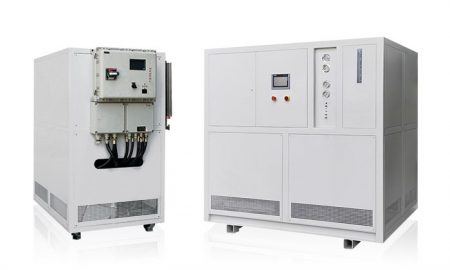
Refroidisseurs basse température (refroidis par eau et par air)
Plage de contrôle de la température : -150°C à -5°C
Nous sommes spécialisés dans la production de refroidisseurs à basse température avec une plage de contrôle de la température allant jusqu'à -150°C, qui peuvent répondre aux besoins de réfrigération de différentes industries.
| Plage de température | Série -25°C ~ -5°C | Série -45°C ~ -10°C | Série -60°C ~ -10°C | Série -80°C ~ -30°C | Série -110°C ~ -50°C |
| Capacité de refroidissement | jusqu'à 360 kW | jusqu'à 360 kW | jusqu'à 360 kW | jusqu'à 270 kW | jusqu'à 180 kW |
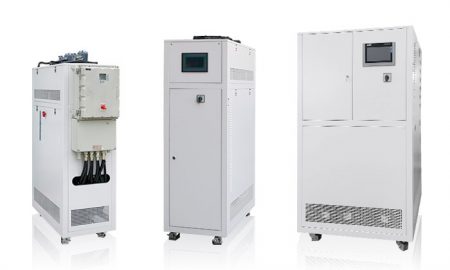
Refroidisseurs à circulation (Refroidissement par eau et par air)
Plage de contrôle de la température : -120°C à +30°C
Notre refroidisseur à circulation adopte une technologie de réfrigération à basse température, la température est aussi basse que -120℃, et divers accessoires sont personnalisables.
| Plage de température | Série -25°C ~ +30°C | Série -45°C ~ +30°C | Série -60°C ~ -20°C | Série -80°C ~ -20°C | Série -120°C ~ -70°C |
| Capacité de refroidissement | jusqu'à 38 kW | jusqu'à 12 kW | jusqu'à 7,2 kW | jusqu'à 7,2 kW | jusqu'à 8,6 kW |
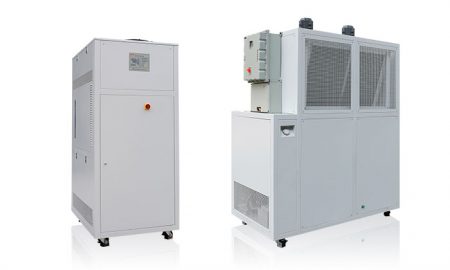
Refroidisseurs à température ambiante / Petits refroidisseurs
Plage de contrôle de la température : +5°C à +50°C
Le refroidisseur peut être largement utilisé dans diverses industries et laboratoires, et peut être conçu sur mesure.
| Plage de température | -18°C ~ +30°C | Série +5°C ~ +35°C |
| Capacité de refroidissement | jusqu'à 0,9 kW | jusqu'à 50 kW |
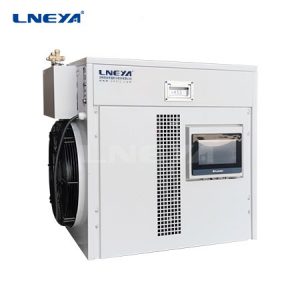
Équipements de réfrigération à refroidissement direct
Plage de contrôle de la température : -120°C à -10°C
Il convient aux endroits où la surface d'échange de chaleur est faible et où l'échange de chaleur est important.
| Plage de température | -40°C ~ -10°C | -80°C ~ -35°C | -120°C ~ -90°C |
| Puissance du compresseur | jusqu'à 8HP | jusqu'à 8HP*2 | jusqu'à 45HP*3 |

Refroidissement direct Refroidisseurs à très basse température
Plage de contrôle de la température : -150°C à -110°C
Des solutions personnalisées pour votre entreprise.
| Plage de température | -150°C ~ -110°C |
| Capacité de refroidissement | jusqu'à 11 kW |
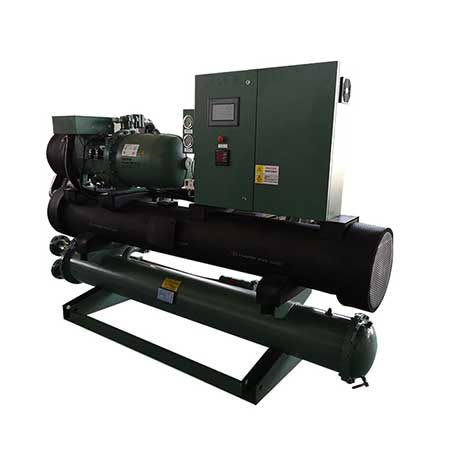
Refroidisseurs à vis
Refroidisseurs à vis à basse température et refroidisseurs à vis à température ambiante
Des solutions personnalisées pour votre entreprise.
| Plage de température | +5°C ~ +30°C | +5°C ~ +30°C | +5°C ~ +30°C | +5°C ~ +30°C | -25°C ~ +5°C | -25°C ~ +5°C |
| Capacité de refroidissement | jusqu'à 1027 kW (compresseur unique) | jusqu'à 2134 kW (double compresseur) | jusqu'à 934 kW (compresseur unique) | jusqu'à 1940 kW (double compresseur) | jusqu'à 467 kW (compresseur unique) | jusqu'à 497 kW (compresseur unique) |
 LNEYA
LNEYA
 简体中文
简体中文












































































